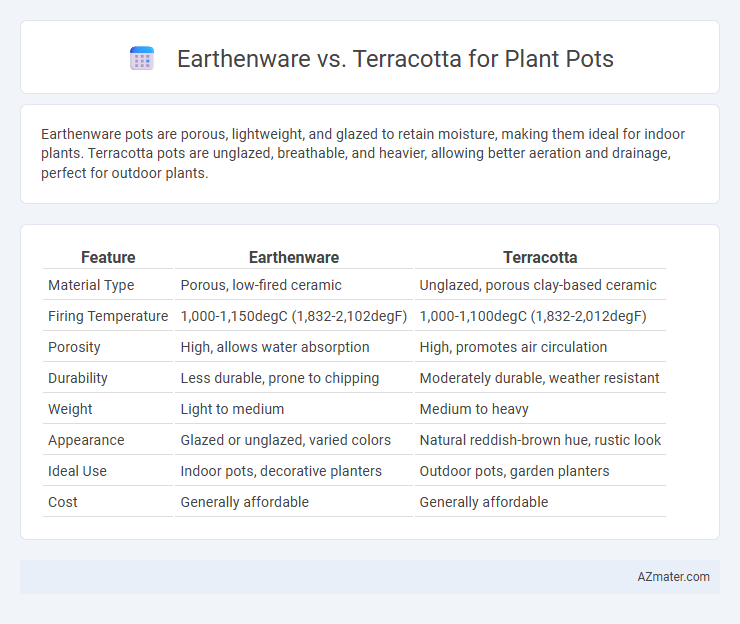Earthenware pots are porous, lightweight, and glazed to retain moisture, making them ideal for indoor plants. Terracotta pots are unglazed, breathable, and heavier, allowing better aeration and drainage, perfect for outdoor plants.
Table of Comparison
| Feature | Earthenware | Terracotta |
|---|---|---|
| Material Type | Porous, low-fired ceramic | Unglazed, porous clay-based ceramic |
| Firing Temperature | 1,000-1,150degC (1,832-2,102degF) | 1,000-1,100degC (1,832-2,012degF) |
| Porosity | High, allows water absorption | High, promotes air circulation |
| Durability | Less durable, prone to chipping | Moderately durable, weather resistant |
| Weight | Light to medium | Medium to heavy |
| Appearance | Glazed or unglazed, varied colors | Natural reddish-brown hue, rustic look |
| Ideal Use | Indoor pots, decorative planters | Outdoor pots, garden planters |
| Cost | Generally affordable | Generally affordable |
Understanding Earthenware: Composition and Uses
Earthenware is a porous ceramic made from natural clay fired at relatively low temperatures, typically between 1,000degC and 1,150degC, resulting in a softer, more porous material compared to terracotta. Its composition often includes a mix of clay, quartz, and feldspar, which influences its durability and water retention properties, making it ideal for decorative plant pots that require good moisture regulation. Commonly used for both indoor and outdoor plant pots, earthenware offers superior breathability, promoting healthy root systems by allowing air and water to pass through the vessel walls.
What is Terracotta? Key Features Explained
Terracotta is a type of earthenware clay known for its porous, reddish-brown color and natural composition, making it highly breathable and ideal for plant pots that require good moisture regulation. Its key features include excellent drainage, durability in outdoor conditions, and a rustic aesthetic that enhances garden decor while promoting healthy root systems. Unlike other earthenware, terracotta pots absorb excess water, preventing root rot and enabling plants to thrive in well-ventilated soil environments.
Earthenware vs Terracotta: Material Differences
Earthenware and terracotta both consist of clay but differ significantly in composition and firing temperature, influencing their durability and porosity. Earthenware is fired at lower temperatures, resulting in a more porous and less dense material, which requires glazing to prevent water absorption and enhance longevity. Terracotta, a subtype of earthenware, is typically unglazed and fired at higher temperatures, producing a more robust, reddish-brown pot ideal for breathability and root health in plants.
Porosity and Drainage: Which is Better for Plants?
Earthenware plant pots exhibit higher porosity than terracotta, allowing better air circulation and moisture evaporation, which helps prevent root rot in many plants. Terracotta pots, while also porous, often have a denser composition that retains moisture slightly longer, making them suitable for plants requiring more consistent hydration. Choosing between earthenware and terracotta depends on the specific drainage needs of your plants and the growing environment conditions.
Aesthetic Comparison: Color, Texture, and Style
Earthenware plant pots offer a broader color palette including natural reds, browns, and glazes that enhance aesthetic appeal, while terracotta pots are characterized by their distinctive warm, reddish-brown hue. The texture of earthenware is typically smoother and can be glazed for a glossy finish, contrasting with the porous, matte surface of terracotta that ages with a rustic charm. In terms of style, earthenware pots often provide a refined, decorative look suitable for indoor settings, whereas terracotta's classic, earthy appearance complements outdoor and traditional garden designs.
Durability: Longevity of Earthenware and Terracotta Pots
Earthenware pots typically offer less durability compared to terracotta due to their more porous, softer clay composition, making them more prone to chipping and cracking over time. Terracotta pots, fired at higher temperatures, exhibit greater strength and longevity, able to withstand outdoor weather conditions better. Choosing terracotta ensures longer-lasting plant container performance, especially in varying climates.
Weight and Portability: Handling Each Pot Type
Earthenware pots are generally heavier and less porous compared to terracotta, making them more durable but less portable for frequent rearranging in gardens or patios. Terracotta pots, known for their lightweight and porous nature, offer easier handling and better breathability for plant roots, ideal for indoor use or spots requiring regular movement. When selecting between the two, consider the balance between the sturdiness of earthenware and the portability advantages of terracotta for specific gardening needs.
Suitability for Indoor vs Outdoor Gardening
Earthenware pots, made from porous clay, are ideal for outdoor gardening due to their breathability and moisture regulation, which prevents root rot in plants exposed to varying weather conditions. Terracotta pots, a type of earthenware, also offer excellent air permeability but tend to be more fragile and prone to cracking in freezing temperatures, making them better suited for indoor use in controlled environments. Both materials provide aesthetic charm and natural insulation, but terracotta's susceptibility to frost limits its outdoor suitability in colder climates.
Cost Comparison: Earthenware vs Terracotta Plant Pots
Earthenware plant pots generally cost more than terracotta pots due to their glazed finish and varied designs, which contribute to higher production expenses. Terracotta pots are often more budget-friendly, as they are made from natural clay fired at lower temperatures, resulting in simpler, unglazed textures and reduced manufacturing costs. When selecting between the two, the choice often depends on balancing aesthetic preferences against cost efficiency for gardening projects.
Best Uses: Choosing the Right Pot for Your Plants
Earthenware pots offer porous properties that support air and water flow, making them ideal for plants requiring well-drained soil like succulents and cacti. Terracotta pots, known for their durability and natural reddish-brown color, excel in maintaining moisture balance for herbs and flowering plants. Selecting the right pot depends on plant type, watering habits, and desired aesthetic, ensuring optimal growth and health.

Infographic: Earthenware vs Terracotta for Plant Pot
 azmater.com
azmater.com